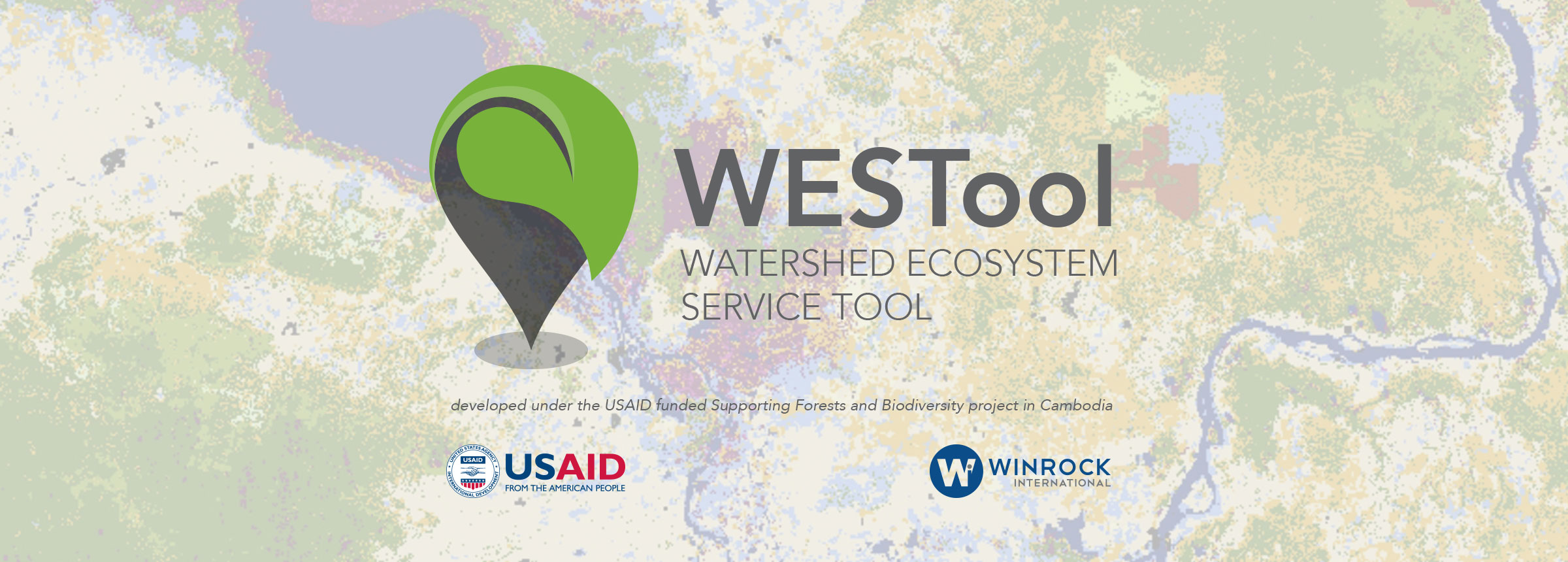
Data Sources
District Boundaries
District boundaries were derived from the Global Administrative Boundaries (GADM) spatial database, available at http://www.gadm.org/
Land Cover Map (2000-2015)
The land cover map was developed by Winrock International by combining the University of Maryland’s layers of tree cover and forest loss between 2000-2015 with a dataset developed by Wohlfart et al. (2014) that shows the area of the dry deciduous dipterocarp forests of Southeast Asia. For the non-forest land cover the European Space Agency (ESA) Globe Cover data product was used.
- Hansen MC, Potapov PV, Moore R, Hancher M, Turubanova SA, Tyukavina A, Thau D, Stehman SV, Goetz SJ, Loveland TR, Kommareddy A, Egorov A, Chini L, Justice CO, Townshend JRG (2013) High-resolution global maps of 21st century forest cover change. Science: 342 (6160), 850-853
- Wohlfart, Christian, Martin Wegmann, and Peter Leimgruber. “Mapping threatened dry deciduous dipterocarp forest in South-east Asia for conservation management.” Tropical Conservation Science 7, no. 4 (2014): 597-613.
- Source Data: © ESA / ESA Globcover 2005 Project, led by MEDIAS-France/POSTEL Image: © ESA / ESA Globcover 2005 Project, led by MEDIAS-France/POSTEL
Carbon Emissions
The Carbon Emissions data layer was produced by combining the land cover map with carbon stock estimates derived from:
- World Conservation Society (WCS) field data for the Seima REDD project
- Conservation International (CI) field data from Prey Lang Protected Area
- Oddar Menchey REDD Project Document field data
- Flora and Fauna International (FFI) field data from the Cardamon Protection Forest
Population (2001 & 2008)
This data layer was generated by combining 2008 census data at the village and commune levels, obtained from Open Development Cambodia (http://www.opendevelopmentcambodia.net/maps/downloads/) and the global population density dataset LandScan (http://web.ornl.gov/sci/landscan/). The 2008 census data at the village scale was made spatially explicit (at the 1 km pixel scale) by projecting the population over the landscape, assigning values proportionally given population density from the LandScan map. To create the 2001 map, the 2008 population numbers from the census were scaled down to match the numbers from the LandScan map in 2001.
Potential Agricultural Productivity
This layer was created by combining several layers that affect agricultural productivity, including:
- Annual precipitation (from the global WorldClim database) (http://www.worldclim.org/)
- Available water content of the soil (an output from hydrological modeling as detailed in the WESTool Soil and Water Protection page)
- Slope (calculated from a digital elevation model)
- Soil fertility (downloaded from Open Development Cambodia) (http://www.opendevelopmentcambodia.net/maps/downloads/)
Yield Per Hectare and Rice Cultivation
This data layer was developed using information from the Commune Database downloaded from Open Development Cambodia (http://www.opendevelopmentcambodia.net/maps/downloads/). The Commune Database supplies a range of commune-level statistics including information on rice cultivation. Total rice paddy yield in tonnes for each commune for both the wet and dry seasons of 2009 were summed and divided by the total number of hectares under rice paddy cultivation in 2009 for both seasons to obtain an average yield per hectare.
Total Cultivation Area
This layer was also developed using information on rice cultivation from the Commune Database downloaded from Open Development Cambodia (http://www.opendevelopmentcambodia.net/maps/downloads/). It shows the summation of the total number of hectares under rice paddy cultivation in 2009 for both the dry and wet seasons.
Access to Market
This layer was obtained from the European Union Joint Research Center’s global accessibility map available at http://bioval.jrc.ec.europa.eu/products/gam/.
Sediment and Nutrient Loss and Prevention
Soil and Water Assessment Tool (SWAT) computer model was used to create the data layers reflecting estimates of sediment and nutrient loss as a result of deforestation in Cambodia. SWAT uses data on weather, topography, land cover, and soil to simulate the hydrologic cycle and predict the amount of sediment lost. Data sources included:
- Soil data were sourced from the Harmonized World Soil database, available at http://webarchive.iiasa.ac.at/Research/LUC/External-World-soil-database/HTML/
- Topography data were sourced from NASA’s Shuttle Radar Topography Mission (SRTM), available at http://www2.jpl.nasa.gov/srtm/
- Land management
- Climate data from dozens of weather stations across Cambodia were sourced from the http://www.ncdc.noaa.gov/
More detail on methods used for SWAT hydrological modeling are detailed in the WESTool Soil and Water Protection page.
Watersheds
This layer was developed through SWAT hydrological modeling, combined with Mekong River Comission watershed from Cambodia
Rivers and River Points
This layer was developed through SWAT hydrological modeling, combined with Mekong River Comission watershed from Cambodia
Historical Climate Data
Global Historical Climatology Network rain gauge locations, downloaded from the National Climatic Data Center (NCDC)
Available online at: http://www.ncdc.noaa.gov/
Aquifer Recharge
This layer was developed through SWAT hydrological modeling, using data inputs described above.
More detail on methods used for SWAT hydrological modeling are detailed in the WESTool Soil and Water Protection page.
Avoided Carbon Emissions
The Land Cover and Cambodia layer described above was combined with estimated carbon stocks for standing forests across Cambodia (as of 2013), sourced from field datasets used for the Carbon Emissions layer (described above). As different forest types across Cambodia contain different average carbon stocks (i.e., open forests have less carbon stocks than closed and wetland forests, and therefore would cause more emissions if cleared), forest types with higher carbon stocks were assigned a higher value of avoided carbon emissions.
Biodiversity
This data layer was generated using the “Key Biodiversity Areas of Cambodia” data layer developed by BirdLife International, Conservation International, the Critical Ecosystem Partnership Fund and WWF Cambodia Programme available at http://www.opendevelopmentcambodia.net/
Protected Areas
downloaded from Open Development Cambodia website
Projected future climate model (GCM)
Maps of predicted change in precipitation and temperature were derived from the MIROC3.2 global circulation model through the downscaled climate model simulations (CMIP3). Methods for the downscaling are described in the following manuscripts:
- Girvetz, E.H., E.P. Maurer, P. Duffy, A. Ruesch, B. Thrasher, C. Zganjar, 2013, Making Climate Data Relevant to Decision Making: The important details of Spatial and Temporal Downscaling, The World Bank, March 27, 2013, 43 pp.
- Thrasher, B., E.P. Maurer, C. McKellar and P.B. Duffy, 2012, Technical Note: Bias correcting climate model simulated daily temperature extremes with quantile mapping, Hydrology and Earth Systems Science 16, 3309–3314, doi:10.5194/hess-16-3309-2012
Water stress days
The water stress maps was developed using outputs from the SWAT computer model, which analyzes historical weather data to predict average days of crop stress. Regressions were developed between rainfall and days of water stress. These relationships were applied to current annual average precipitation rates (obtained from the WorldClim database) and future predicted change in precipitation rates as provided by the GCM data.
Change in crop yield
The change in crop yield data was developed by creating a relationship between water stress days and crop yield as predicted by the SWAT model. With a given current rainfall amount and predicted future rainfall amount based on GCM data, a future water stress was predicted and subsequently future crop yield was predicted and compared to current crop yields.
Flood extent: the area of possible inundation layer was obtained from the Global Surface Water dataset. The layer used is the maximum water extent, which shows all areas that have been inundated over the last 32 years as mapped by Landsat satellite images. Citation:
- Jean-Francois Pekel, Andrew Cottam, Noel Gorelick, Alan S. Belward, High-resolution mapping of global surface water and its long-term changes. Nature 540, 418-422 (2016). (doi:10.1038/nature20584)
- KEEP THIS IN MIND FOR WESTOOL DISPLAY: If you are using the data as a layer in a published map, please include the following attribution text: ‘Source: EC JRC/Google’
Fire frequency
The fire frequency layer uses all the MODIS-mapped fire hotspots in Cambodia between 2000 and 2015 (data source: http://modis-fire.umd.edu/index.php). Then, a point frequency maps was created to show how many hotspots were detected nearby each point on the map. The map shows only historical frequency of fire, many of which may have been due to human-induced land clearing fires, rather than predicted risk of future fire.
Landslide
The landslide map is a map of slope which was created from a SRTM satellite digital elevation model (DEM) or map of elevation (http://www.cgiar-csi.org/data/srtm-90m-digital-elevation-database-v4-1). Given that there are many other factors other than slope that contribute to landslide risk, this map is most likely a simplistic representation of actual risk.
How to Cite WESTool
Watershed Ecosystem Service Tool (WESTool). 2017. Beta Version 1. https://winrock.org/westool/. Winrock International







